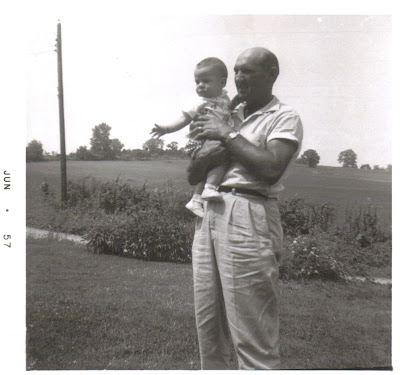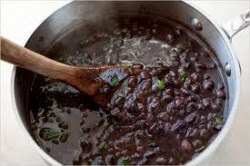 |
| Uncle Howard, Aunt Dorothy, and Dad in front of the house - circa 1945 |
The house was built in 1895 - my father and his siblings were all raised in the house by Aunt Maxine after their young mother died. The house had a side porch made of wood planks. Walking out the side door to the porch, you could walk straight ahead and step about 6 inches down to the ground. But as I said, the property sloped steeply on all sides, so if you walked to the left just two feet, you then had to face a drop of about 2 feet. So it always struck me as rather odd that Uncle George would walk out the screen door and move left to step off the steep end of the porch. Why? Why make your life harder? Why put more effort into stepping off the porch when a little step down was available just straight ahead? Lame.
Uncle George built highways for the State of Kentucky for 50 years - got a service award certificate for 25 years that hung proudly in one of their rear guestrooms (how three bedrooms fit into that tiny house I'll never know). He was known for taking the "long way" when it meant doing it right, doing it better. The younger men on his crew would grumble that they didn't have to do all the extra little things Uncle George made them do. But that was Uncle George. You may have not been able to see it, but there was always method to his madness. And so it is now, 10 years after losing him, and as I age myself, that I see why Uncle George continued, even at age 85, to step off the steep side of the porch. He was challenging himself, forcing his body to do the things he had always been able to do. He wanted to continue doing them.
 |
| Uncle George and me |
Uncle George was fighting nature - our inclination to make life as easy as possible. So why not take the easy road? Well, I would like to be around at least as long as my Uncle George, who passed away at age 88, and not because of any physical ailment; he was heartbroken because he had lost Maxine just six months earlier.
I once heard a woman of 75, who was leading an exercise class, say "motion is lotion", and I guess I am trying to adopt that strategy of having a fruitful old age where I can still do all the things I want. I want to hike the Alps again, I want to swim in the Mediterranean Sea, and I want to retire to a small village somewhere where you walk to the local market each day for your fruits, vegetables, and meats. If motion is, indeed, lotion, then I want to slather myself with it every day, whether I like it or not. After all, it is so much easier to take that bus, hop that taxi, or just stay home and sit in front of the TV. I'm fighting my natural instinct to take it easy, but that won't get me where I want to go.
So here's to my Uncle George, who taught me many things, not the least of which is how to live a vital existence. I'll do my best to take the higher step down.











